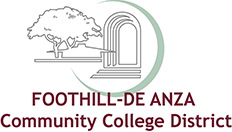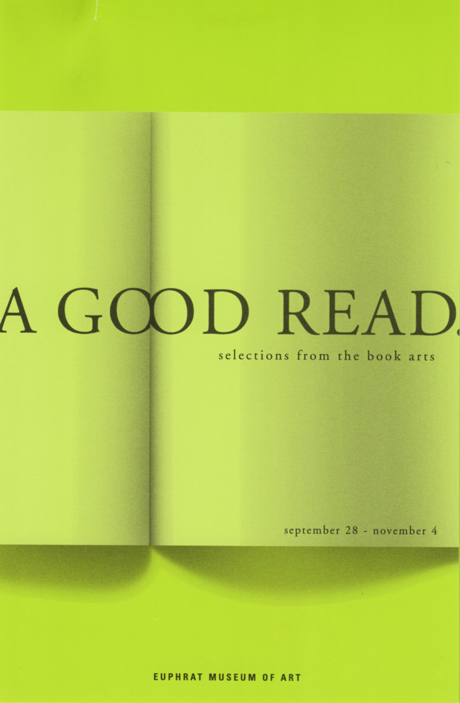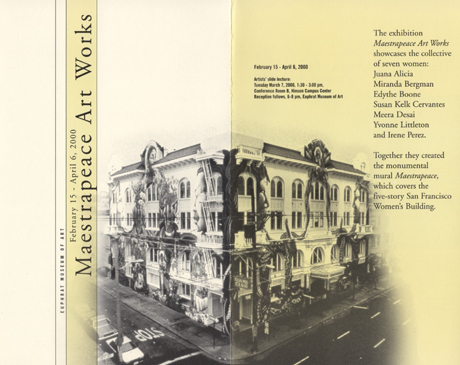1999-2000
Fall 1999
A Good Read, Selections from the Book Arts
9/28-11/9/99
Artists include Etel Adnan, Francisco X. Alarcon, Enrique Chagoya, Julie Chen, Robert Chiarito, Gabriel A. Ella, Guillermo Gomez-Peña, Ghada Jamal, Jeffrey Kao, Amos Paul Kennedy Jr., Bita Kavehzadeh, Lisa Kokin, Marlene Larson, Debra J. Lewis, Tobie Lurie, Jone Manoogian, Kent Mansky, Nance O'Banion, Bonnie O'Connell, Felicia Rice, Ray Rice, Elba Rosario Sanchez, Carla Trefethen Saunders, Karen Sjoholm, Nanette Wylde.
Curatorial assistance from Michael Day, Julian E. Gómez, Kent Manske, Karen Sjoholm, Flo Oy Wong.
A Good Read presented books as a growing art form, including diverse artists' conceptions today, traditional examples, different cultural perspectives, and interactive forms, such as electronic books. We worked with book groups (e.g. the South Bay Chapter Women's Caucus for Art (SBWCA)), small book presses (e.g. Moving Parts Press, Santa Cruz), and academic book arts programs (at JFK University, CCAC, U. of Nebraska, Indiana U., etc.). Codex Espangliensis from Columbus to the Border Patrol, with text by Guillermo Gómez-Peña, imagery by Enrique Chagoya, and bookwork by Felicia Rice tells a story of cultural hybrids and political collisions through a montage of contemporary text, cartoons, and pre-hispanic drawings. Carla Trefethen Saunders constructed one book from an old wine crate, one from a painting that folds up, another from a roll of film. Collaboration with Foothill faculty member Kent Manske and student Michael Kaluzhinsky, who created a research website for the Euphrat's A Good Read exhibition. The website presented vocabulary, resources, and current exhibitions relating to book arts. South Bay Area Women's Caucus for Art newsletter, 10/99. Companion exhibition curated for Sunnyvale Creative Arts Center Gallery, Artists' Books, Art from Books, Sketchbooks, 11/2-12/11/99, Kay Kang, Catie O'Leary, and selected members of the South Bay Bookies, a subgroup of the South Bay Area Chapter Women's Caucus for Art: Sandra Beard, Diane Cassidy, Constance Guidotti, Judith Hoffman, Jone Manoogian, Kent Manske, Trudy Myrrh, M. J. Orcutt, Nanette Wylde.
View ancillary materials for the Fall 1999 exhibitions.
Winter 2000
Passing (Why is it people feel the need to pass for something they are not?)
11/23/99-1/27/00
Artists include Candi Farlice, Daniel Harris, Kay Kang, Lisa Kokin, Gayle Tanaka, Cynthia Tom, Timothy Taylor, Flo Oy Wong.
Passing grew from an idea of artist co-curator Candi Farlice. When she was a child, she asked her mother, "Why does Hollis only come over at night?" The answer: "Because he's passing." While this instance was racial passing, the show addressed multiple forms and reasons - some people passing for advancement, others for survival. Artists and educators participated in the show's development. The exhibition Passing focused on the activity of passing for something else, on what is gained and what is lost. Immigrants often drop part of their surname or change it completely. Others pass for other cultures or races, perhaps for advancement, perhaps for survival. Most of us pass at one time or another. Demographics change when people are "in the closet." On the personal level, not being the person you are, your life can become a "lie." From another angle, passing can be connected with becoming - for example by way of surgery, education, or accumulation of wealth. The art of passing can be a positive life skill. The Passing exhibition examined this activity from a variety of viewpoints, such as race, ethnicity, class, and sexual orientation.
View ancillary materials for the Winter 2000 exhibitions.
Spring 2000
Maestrapeace Art Works
2/15-4/6/00
Artists include Juana Alicia, Miranda Bergman, Edythe Boone, Susan Kelk Cervantes, Meera Desai, Yvonne Littleton, Irene Perez.
Maestrapeace spotlighted the work of seven muralists, all women, who designed and painted the internationally acclaimed monumental mural Maestrapeace on the San Francisco Women's Building. The mural is a testament to cultural diversity, inclusion, community involvement, and artistic collaboration. The show highlighted their processes, art, and activism. During the last two weeks, the exhibition incorporated Homage to Maestrapeace fabric panels, a collaborative public artwork created by hundreds of local elmentary school students through the Arts & Schools Program. Photo: 12,000 square feet. Acrylic mural on San Francisco Women's Building, 3543 18th Street. Maestrapeace honors famous and unsung women, highlights political activism, artistic and scientific achievements, and proclaims the healing power of women's wisdom. The figuration spans centuries through the combination of ancient spiritual icons with modern portraiture of women and girls in all stages of life. Maestrapeace Art Works is a prestigious team of seven artists from different cultures and generations. The exhibition presents the mural and the process of creating it, along with artworks by the individual artists and current projects. The mural is the first of its kind, a mural devoted to women's history, and it is relevant to anyone who has wanted to see their dreams and visions recognized on a monumental scale. A tribute to the often hidden history of women's contributions to societies worldwide, Maestrapeace conveys cultural diversity and inclusion through portraiture, icons, fabric patterns, and 500 calligraphed names of women. In 2000, the Maestrapeace artists are celebrating the sixth anniversary of finishing the mural, the organization of Maestrapeace Art Works to continue their collaborative work together, and a "rebirth" of the mural with new sections to be unveiled in conjunction with building changes in 2000. Their process is a testament to community involvement and artistic collaboration. The exhibition and written material touch upon how to build community participation in a professionally painted mural, what assistance or lessons the community mural process can give to community organizing, and how the dynamic tension between individual and collective work can heighten both processes. Maestrapeace artists' slide lecture, 3/7. Cosponsors De Anza Visiting Speakers Committee, Women's History Month Committee, DASB, other committees. Video was produced. Lecture on art and feminism given by Director as part of Women's History Month activities, 3/8/00.
View ancillary materials for the Spring 2000 exhibitions.



